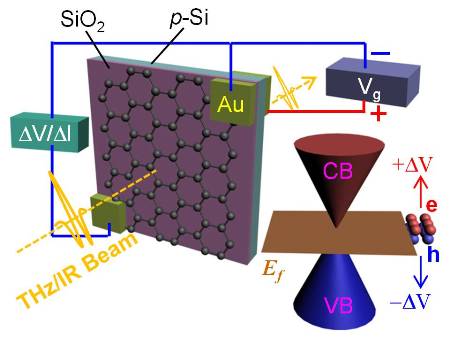A team of researchers from the Rice University and Osaka University’s Institute of Laser Engineering has discovered a way to manipulate the transmission of electromagnetic radiation having wavelengths between terahertz and midinfrared.
 Experiments at Rice University showed that voltage applied to a sheet of graphene on a silicon-based substrate can turn it into a shutter for both terahertz and infrared wavelengths of light. Changing the voltage alters the Fermi energy (Ef) of the graphene, which controls the transmission or absorption of the beam.(Graphic by Lei Ren/Rice University)
Experiments at Rice University showed that voltage applied to a sheet of graphene on a silicon-based substrate can turn it into a shutter for both terahertz and infrared wavelengths of light. Changing the voltage alters the Fermi energy (Ef) of the graphene, which controls the transmission or absorption of the beam.(Graphic by Lei Ren/Rice University)
The new research led by Junichiro Kono, a Rice lab physicist, is a significant progress in the science of controlling light of specific wavelengths which could be applied in the development of advanced optoelectronic sensing devices and electronics. The study results have been published in Nano Letters, a journal of the American Chemical Society.
In the experiment, the researchers used a centimeter-square graphene sheet that was produced in the laboratory of James Tour, a Rice chemist and a co-author of the paper. They then attached gold electrodes to the corners of the graphene sheet. When they applied an electrical voltage to this set up, the graphene sheet served as a shutter or a filter for light by manipulating Fermi energy, which is the energy level of a material’s electrons that have the highest occupied quantum state.
Kono informed that the words, ‘large area’ and ‘gated’ are the key to the latest research. The word ‘large area’ means that terahertz and infrared have longer wavelengths and hence it is difficult to focus them on a tiny area. The word ‘gated’ refers to the application of voltage between the silicon substrate and the attached gold electrodes to manipulate the Fermi energy.
The Fermi energy in the graphene sheet was tuned by lowering or increasing the applied voltage, thus changing the density of free carriers, which can absorb infrared and terahertz waves. With these changes, the graphene sheet was now able to absorb part or all of the infrared or terahertz waves or allow them to pass.
The researchers found that changing the wavelength of light comprising both infrared and terahertz frequencies allowed a shift from the absorption of one frequency to the other. They also discovered that heating or thermal annealing of graphene changes its Fermi energy by cleaning it of impurities. Kono lab’s next move is to develop devices and explore new methods to control light, possibly by integrating graphene with plasmonic components that may enable a better control.
Source: http://www.rice.edu/